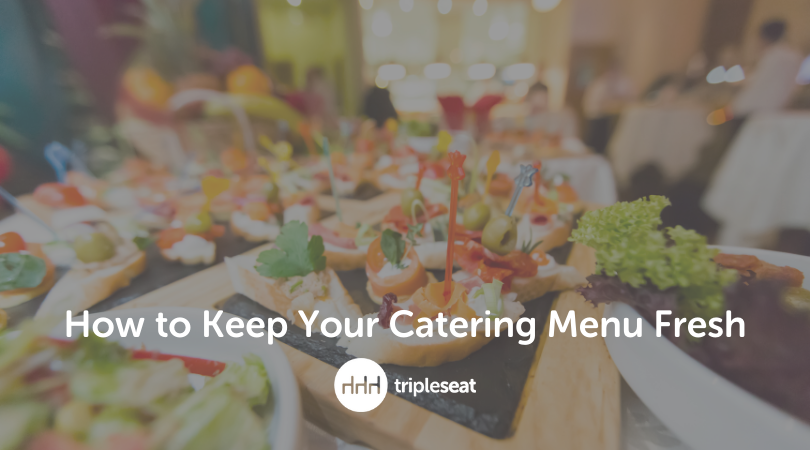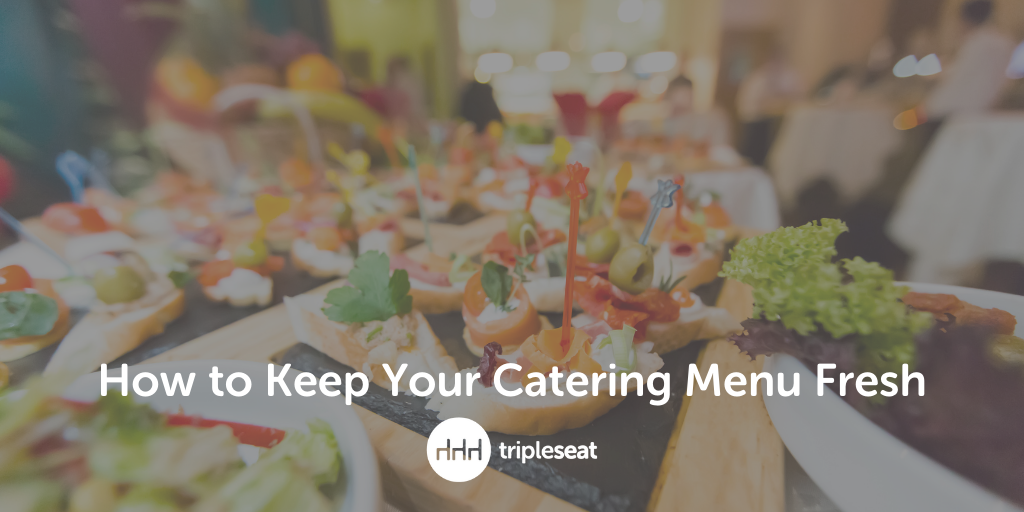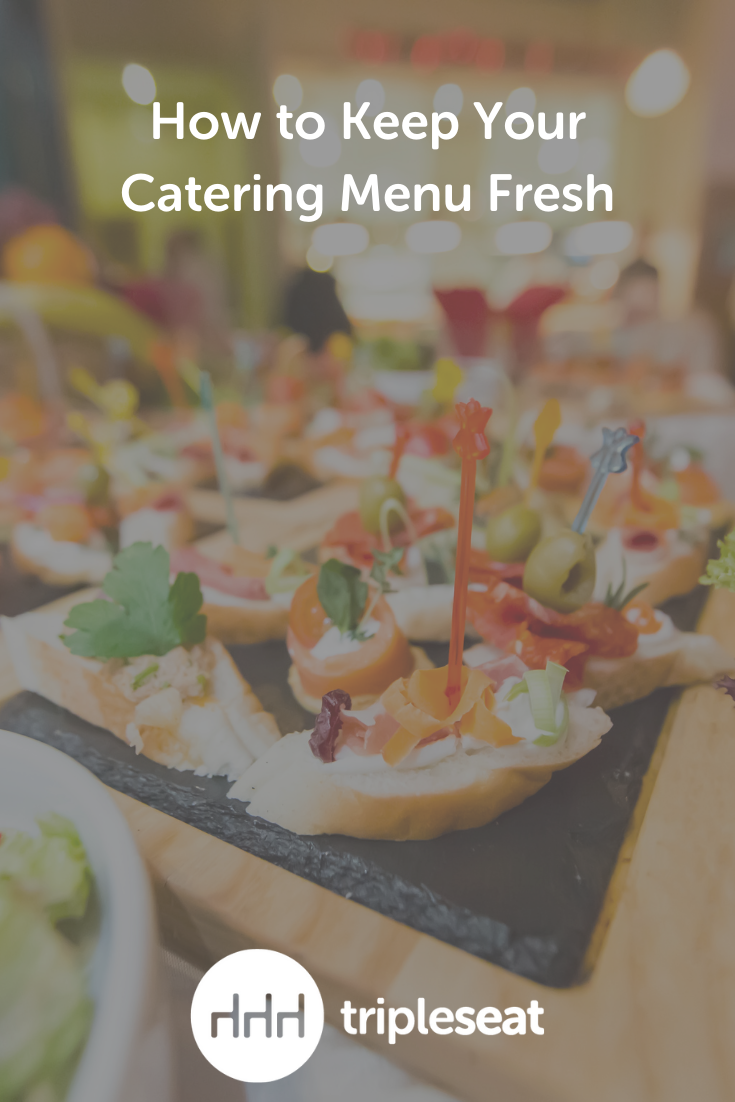How to Keep Your Catering Menu Fresh

As a catering company, your menu can be the deciding factor that motivates a potential client to (virtually) sign on the dotted line. Those who do it well know it’s crucial to go beyond one-size-fits-all menus.
Instead, you need enough options to cover as many event types as possible, while keeping in mind everything from dietary restrictions to serving style.
So, how do you keep your catering menu fresh? How do you keep ever-changing seasons and trends in mind? And how do you craft menus that will appeal to a wide array of clients? We’ve compiled a handful of catering menu tips that’ll ensure your offerings stand out from the crowd.
We also chatted with Stephanie Annis, general manager at Dogwood Catering. She talked to us about the many ways her company has kept their catering menus innovative — and scored more business in the process.
1. Leverage seasonal ingredients
Reports show that more than half (59%) of consumers are more likely to purchase an item on a restaurant menu if it’s described as “seasonal.” Taking advantage of seasonal ingredients is an easy way to update your menu and impress your clients. Using these ingredients provides your team with new menu options to play with. (Bonus points if they’re locally sourced.)
They’ll also often be cheaper and of higher quality, allowing you to bring in more revenue. “We get seasonal food requests all the time. They’re great because they not only keep pricing lower but help us keep within the theme of events we’re throwing,” Annis said.
2. Be mindful of dietary restrictions
Gluten-free, vegan, lactose intolerant — dietary restrictions run the gamut. And even though millions of people have food allergies, that doesn’t mean you should simply assume a prospect or customer will ask if you cater to those with special diets.
Rather, it’s better to go ahead and have these options available on your menus. This way, no one feels high-maintenance or like an inconvenience for needing a dairy-free dish on the dessert menu. It also never hurts to mention that, if an option doesn’t currently exist on your menu for a particular allergy, you’re happy to accommodate.
3. Keep the serving style in mind
Anyone who’s ever struggled to cut an oversized appetizer with a plastic fork while balancing to plate on top of their cocktail knows that serving style matters when it comes to catered events. Coming up with a variety of menu options that cater to different guest sizes, event styles, and venue types shows clients you pay attention to detail. It also shows you’ve thought through what will work best for their guests.
Depending on the event, you could be catering a sit-down dinner, buffet-style dishes, or passed hors d’oeuvres. For a sit-down dinner, you can offer items like pasta or steak that require cutlery. Buffet-style events are a great way to show off foods that work well in big batches, like mashed potatoes and pasta salad. For hors d’oeuvres, you’ll want to offer small, bite-sized foods that your guests can eat with one hand while standing and without silverware.
4. Have a variety of themed packages
A creative way to update your catering menu is to offer themed packages for your guests. You could put a New Orleans spin on your catering menu for Mardi Gras or offer food fit to eat in a ball gown (cake pops with gold sprinkles are a sure win) for an Oscars extravaganza.
Even time-of-day specialty packages, like classic brunch favorites or a late-night dessert bar, can be a hit, particularly with millennial crowds. You can also tailor menus to national holidays like Thanksgiving, Christmas, or the Fourth of July.
5. Be flexible when it comes to unpredictable weather
Summertime is synonymous with grilling, cold drinks, and outdoor fun in the sun. When temperatures are starting to rise, consider switching up your catering menu to add on some simple, light options for these events.
Fresh fruit and raw veggies with an array of dips are always visually appealing crowd-pleasers. The same goes for catering a winter event — consider serving foods that are warm and comforting, like soups, chili, and hot beverages. “We are always continuing our education on trends and staying ahead of the seasons to keep our catering menus fresh,” Annis said.
6. Consider DIY food stations
DIY stations are a bonafide event trend, so why not incorporate it into your catering stations? While particularly popular at wedding receptions, DIY food bars can also be featured at networking events, birthday parties, and corporate gatherings.
These stations allow guests to personalize the food at the event. It also gives them the opportunity to have some fun curating their own plates. Customizable s’mores, tacos, mimosas, fondue, and pretzel bars are all memorable options that your guests will love. And, let’s face it: They’re Instagram-friendly too.
7. Get creative with menu descriptions
Changing up your catering menu doesn’t always have to mean introducing new items. Playing around with your menu descriptions is a simple way to make your offerings more appealing and memorable. It’s also a great way to convey the feel of your brand.
Think of short, fun ways to describe your dishes or themed packages instead of just listing ingredients below each item. Menu descriptions are a great way to feature your brand voice — whether that’s sophisticated, quirky, playful, or something in between.
8. Highlight what makes you stand out
You only get one chance to make a first impression. Because of this, it’s crucial to set yourself apart from competitors — that goes for your menu, too.
Rise & Shine Catering in Los Angeles doesn’t just offer catering. They can also provide floral arrangements, box lunches, a full staff (including bartenders, servers, and day-of coordinators), and custom floral arrangements. By putting all of this info near the front of your restaurant menu packet, you can catch the eye of those looking for more than just a warm meal.
9. Have different food options for small and large events
It’s a good idea to have various menu items depending on the size of the party you’re catering. With smaller crowds, you can offer bigger plates or multiple courses. Bigger parties may require smaller bites to keep costs down while allowing partygoers to mingle easily.
Keep in mind that you have to keep menu items fresh-tasting for hours, potentially, and your warm or hot items may need to stay that way for a long period of time. One of the biggest lessons Annis has learned when creating catering menus? “Make sure you don’t get too fancy. You want to be able to replicate your menus for large volumes.”
Manage it all with TripleseatDirect
TripleseatDirect enables restaurants and hotels to offer on-premise and off-premise events and catering to be booked by their clients, directly from their website, social media platforms, or EventUp. TripleseatDirect provides your customers with a simple online booking solution where they can book, plan, and pay for in-house private events, off-site catering, pickup, and delivery with zero friction.
If your venue isn’t using TripleseatDirect feature yet, head on over to our TripleseatDirect page for more information or to book a demo.
Editor’s Note: This post was originally published on the Gather blog and written by Caroline Cox.

